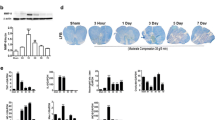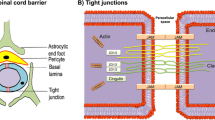Abstract
As a serious trauma of the neurological system, spinal cord injury (SCI) results in permanent disability, gives rise to immediate vascular damage and a wide range of matters that induce the breakage of blood spinal cord barrier (BSCB). SCI activates the expression of MMP-2/9, which are considered to accelerate the disruption of BSCB. Recent research shows that Dl-3-n-butylphthalide (NBP) exerted protective effects on blood spinal cord barrier in animals after SCI, but the underlying molecular mechanism of NBP on the BSCB undergoing SCI is unknown. Here, our research show that NBP inhibited the expression of MMP-2/9, then improved the permeability of BSCB following SCI. After the T9 level of spinal cord performed with a moderate injury, NBP was managed by intragastric administration and further performed once a day. NBP remarkably improved the permeability of BSCB and junction proteins degration, then promoted locomotion recovery. The protective effect of NBP on BSCB destruction is related to the regulation of MMP-2/9 induced by SCI. Moreover, NBP obviously inhibited the MMP-2/9 expression and junction proteins degradation in microvascular endothelial cells. In conclusion, our results indicate that MMP-2/9 are relevant to the breakdown of BSCB, NBP impairs BSCB destruction through inhibiting MMP-2/9 and promotes functional recovery subjected to SCI. NBP is likely to become a new nominee as a therapeutic to treat SCI via a transigent BSCB.





Similar content being viewed by others
References
Oudega M (2012) Molecular and cellular mechanisms underlying the role of blood vessels in spinal cord injury and repair. Cell Tissue Res 349(1):269–288. https://doi.org/10.1007/s00441-012-1440-6
Bartanusz V, Jezova D, Alajajian B, Digicaylioglu M (2011) The blood-spinal cord barrier: morphology and clinical implications. Ann Neurol 70(2):194–206. https://doi.org/10.1002/ana.22421
Hawkins BT, Davis TP (2005) The blood-brain barrier/neurovascular unit in health and disease. Pharmacol Rev 57(2):173–185. https://doi.org/10.1124/pr.57.2.4
Zlokovic BV (2008) The blood-brain barrier in health and chronic neurodegenerative disorders. Neuron 57(2):178–201. https://doi.org/10.1016/j.neuron.2008.01.003
O’Shea NR, Smith AM (2014) Matrix metalloproteases role in bowel inflammation and inflammatory bowel disease: an up to date review. Inflamm Bowel Dis 20(12):2379–2393. https://doi.org/10.1097/MIB.0000000000000163
Sternlicht MD, Werb Z (2001) How matrix metalloproteinases regulate cell behavior. Annu Rev Cell Dev Biol 17:463–516. https://doi.org/10.1146/annurev.cellbio.17.1.463
Werb Z (1997) ECM and cell surface proteolysis: regulating cellular ecology. Cell 91(4):439–442. https://doi.org/10.1016/s0092-8674(00)80429-8
Noble LJ, Donovan F, Igarashi T, Goussev S, Werb Z (2002) Matrix metalloproteinases limit functional recovery after spinal cord injury by modulation of early vascular events. J Neurosci 22(17):7526–7535
Asahi M, Wang X, Mori T, Sumii T, Jung JC, Moskowitz MA, Fini ME, Lo EH (2001) Effects of matrix metalloproteinase-9 gene knock-out on the proteolysis of blood-brain barrier and white matter components after cerebral ischemia. J Neurosci 21(19):7724–7732
Lo EH, Wang X, Cuzner ML (2002) Extracellular proteolysis in brain injury and inflammation: role for plasminogen activators and matrix metalloproteinases. J Neurosci Res 69(1):1–9. https://doi.org/10.1002/jnr.10270
Rosenberg GA, Yang Y (2007) Vasogenic edema due to tight junction disruption by matrix metalloproteinases in cerebral ischemia. Neurosurg Focus 22(5):E4. https://doi.org/10.3171/foc.2007.22.5.5
Lee JY, Choi HY, Ahn HJ, Ju BG, Yune TY (2014) Matrix metalloproteinase-3 promotes early blood-spinal cord barrier disruption and hemorrhage and impairs long-term neurological recovery after spinal cord injury. Am J Pathol 184(11):2985–3000. https://doi.org/10.1016/j.ajpath.2014.07.016
Li L, Zhang B, Tao Y, Wang Y, Wei H, Zhao J, Huang R, Pei Z (2009) dl-3-n-butylphthalide protects endothelial cells against oxidative/nitrosative stress, mitochondrial damage and subsequent cell death after oxygen glucose deprivation in vitro. Brain Res 1290:91–101. https://doi.org/10.1016/j.brainres.2009.07.020
Chang Q, Wang XL (2003) Effects of chiral 3-n-butylphthalide on apoptosis induced by transient focal cerebral ischemia in rats. Acta Pharmacol Sin 24(8):796–804
Xu HL, Feng YP (2000) Inhibitory effects of chiral 3-n-butylphthalide on inflammation following focal ischemic brain injury in rats. Acta Pharmacol Sin 21(5):433–438
Huang JZ, Chen YZ, Su M, Zheng HF, Yang YP, Chen J, Liu CF (2010) dl-3-n-Butylphthalide prevents oxidative damage and reduces mitochondrial dysfunction in an MPP(+)-induced cellular model of Parkinson’s disease. Neurosci Lett 475(2):89–94. https://doi.org/10.1016/j.neulet.2010.03.053
Zhang T, Jia W, Sun X (2010) 3-n-Butylphthalide (NBP) reduces apoptosis and enhances vascular endothelial growth factor (VEGF) up-regulation in diabetic rats. Neurol Res 32(4):390–396. https://doi.org/10.1179/016164110X12670144526264
He Z, Zhou Y, Huang Y, Wang Q, Zheng B, Zhang H, Li J, Liu Y, Wu F, Zhang X, Tong S, Wang M, Wang Z, He H, Xu H, Xiao J (2017) Dl-3-n-butylphthalide improves functional recovery in rats with spinal cord injury by inhibiting endoplasmic reticulum stress-induced apoptosis. Am J Transl Res 9(3):1075–1087
Zheng B, Zhou Y, Zhang H, Yang G, Hong Z, Han D, Wang Q, He Z, Liu Y, Wu F, Zhang X, Tong S, Xu H, Xiao J (2017) Dl-3-n-butylphthalide prevents the disruption of blood-spinal cord barrier via inhibiting endoplasmic reticulum stress following spinal cord injury. Int J Biol Sci 13(12):1520–1531. https://doi.org/10.7150/ijbs.21107
Zheng B, Ye L, Zhou Y, Zhu S, Wang Q, Shi H, Chen D, Wei X, Wang Z, Li X, Xiao J, Xu H, Zhang H (2016) Epidermal growth factor attenuates blood-spinal cord barrier disruption via PI3K/Akt/Rac1 pathway after acute spinal cord injury. J Cell Mol Med 20(6):1062–1075. https://doi.org/10.1111/jcmm.12761
Zhou Y, Zhang H, Zheng B, Ye L, Zhu S, Johnson NR, Wang Z, Wei X, Chen D, Cao G, Fu X, Li X, Xu HZ, Xiao J (2016) Retinoic acid induced-autophagic flux inhibits ER-stress dependent apoptosis and prevents disruption of blood-spinal cord barrier after spinal cord injury. Int J Biol Sci 12(1):87–99. https://doi.org/10.7150/ijbs.13229
Yao Y, Xu J, Yu T, Chen Z, Xiao Z, Wang J, Hu Y, Wu Y, Zhu D (2018) Flufenamic acid inhibits secondary hemorrhage and BSCB disruption after spinal cord injury. Theranostics 8(15):4181–4198. https://doi.org/10.7150/thno.25707
Ye LB, Yu XC, Xia QH, Yang Y, Chen DQ, Wu F, Wei XJ, Zhang X, Zheng BB, Fu XB, Xu HZ, Li XK, Xiao J, Zhang HY (2016) Regulation of Caveolin-1 and junction proteins by bFGF contributes to the integrity of blood-spinal cord barrier and functional recovery. Neurotherapeutics 13(4):844–858. https://doi.org/10.1007/s13311-016-0437-3
Winkler EA, Sengillo JD, Sagare AP, Zhao Z, Ma Q, Zuniga E, Wang Y, Zhong Z, Sullivan JS, Griffin JH, Cleveland DW, Zlokovic BV (2014) Blood-spinal cord barrier disruption contributes to early motor-neuron degeneration in ALS-model mice. Proc Natl Acad Sci USA 111(11):E1035-1042. https://doi.org/10.1073/pnas.1401595111
Yan RY, Wang SJ, Yao GT, Liu ZG, Xiao N (2017) The protective effect and its mechanism of 3-n-butylphthalide pretreatment on cerebral ischemia reperfusion injury in rats. Eur Rev Med Pharmacol Sci 21(22):5275–5282. https://doi.org/10.26355/eurrev_201711_13852
Zhang P, Guo ZF, Xu YM, Li YS, Song JG (2016) N-Butylphthalide (NBP) ameliorated cerebral ischemia reperfusion-induced brain injury via HGF-regulated TLR4/NF-kappaB signaling pathway. Biomed Pharmacother 83:658–666. https://doi.org/10.1016/j.biopha.2016.07.040
Qin C, Zhou P, Wang L, Mamtilahun M, Li W, Zhang Z, Yang GY, Wang Y (2019) Dl-3-N-butylphthalide attenuates ischemic reperfusion injury by improving the function of cerebral artery and circulation. J Cereb Blood Flow Metab 39(10):2011–2021. https://doi.org/10.1177/0271678X18776833
Zhang Y, Huang LJ, Shi S, Xu SF, Wang XL, Peng Y (2016) L-3-n-butylphthalide rescues hippocampal synaptic failure and attenuates neuropathology in aged APP/PS1 mouse model of Alzheimer’s disease. CNS Neurosci Ther 22(12):979–987. https://doi.org/10.1111/cns.12594
Xu J, Huai Y, Meng N, Dong Y, Liu Z, Qi Q, Hu M, Fan M, Jin W, Lv P (2017) L-3-n-butylphthalide activates Akt/mTOR signaling, inhibits neuronal apoptosis and autophagy and improves cognitive impairment in mice with repeated cerebral ischemia-reperfusion injury. Neurochem Res 42(10):2968–2981. https://doi.org/10.1007/s11064-017-2328-3
Chen XQ, Qiu K, Liu H, He Q, Bai JH, Lu W (2019) Application and prospects of butylphthalide for the treatment of neurologic diseases. Chin Med J 132(12):1467–1477. https://doi.org/10.1097/CM9.0000000000000289
Zhang L, Lu L, Chan WM, Huang Y, Wai MS, Yew DT (2012) Effects of dl-3-n-butylphthalide on vascular dementia and angiogenesis. Neurochem Res 37(5):911–919. https://doi.org/10.1007/s11064-011-0663-3
Wang CY, Xu Y, Wang X, Guo C, Wang T, Wang ZY (2019) Dl-3-n-butylphthalide inhibits NLRP3 inflammasome and mitigates Alzheimer’s-like pathology via Nrf2-TXNIP-TrX axis. Antioxid Redox Signal 30(11):1411–1431. https://doi.org/10.1089/ars.2017.7440
Gao M, Ji S, Li J, Zhang S (2019) DL-3-n-butylphthalide (NBP) ameliorates cognitive deficits and CaMKII-mediated long-term potentiation impairment in the hippocampus of diabetic db/db mice. Neurol Res 41(11):1024–1033. https://doi.org/10.1080/01616412.2019.1672387
Lee JY, Choi HY, Park CS, Ju BG, Yune TY (2018) Mithramycin A improves functional recovery by inhibiting BSCB disruption and hemorrhage after spinal cord injury. J Neurotrauma 35(3):508–520. https://doi.org/10.1089/neu.2017.5235
Zhang S, An Q, Wang T, Gao S, Zhou G (2018) Autophagy- and MMP-2/9-mediated reduction and redistribution of ZO-1 contribute to hyperglycemia-increased blood-brain barrier permeability during early reperfusion in stroke. Neuroscience 377:126–137. https://doi.org/10.1016/j.neuroscience.2018.02.035
Cheng Z, Wang L, Qu M, Liang H, Li W, Li Y, Deng L, Zhang Z, Yang GY (2018) Mesenchymal stem cells attenuate blood–brain barrier leakage after cerebral ischemia in mice. J Neuroinflamm 15(1):135. https://doi.org/10.1186/s12974-018-1153-1
Bauer AT, Burgers HF, Rabie T, Marti HH (2010) Matrix metalloproteinase-9 mediates hypoxia-induced vascular leakage in the brain via tight junction rearrangement. J Cereb Blood Flow Metab 30(4):837–848. https://doi.org/10.1038/jcbfm.2009.248
Shen Y, Gu J, Liu Z, Xu C, Qian S, Zhang X, Zhou B, Guan Q, Sun Y, Wang Y, Jin X (2018) Inhibition of HIF-1alpha reduced blood brain barrier damage by regulating MMP-2 and VEGF during acute cerebral ischemia. Front Cell Neurosci 12:288. https://doi.org/10.3389/fncel.2018.00288
Rempe RG, Hartz AMS, Bauer B (2016) Matrix metalloproteinases in the brain and blood–brain barrier: versatile breakers and makers. J Cereb Blood Flow Metab 36(9):1481–1507. https://doi.org/10.1177/0271678X16655551
Feng S, Cen J, Huang Y, Shen H, Yao L, Wang Y, Chen Z (2011) Matrix metalloproteinase-2 and -9 secreted by leukemic cells increase the permeability of blood-brain barrier by disrupting tight junction proteins. PLoS ONE 6(8):e20599. https://doi.org/10.1371/journal.pone.0020599
Lee JY, Kim HS, Choi HY, Oh TH, Yune TY (2012) Fluoxetine inhibits matrix metalloprotease activation and prevents disruption of blood-spinal cord barrier after spinal cord injury. Brain 135(Pt 8):2375–2389. https://doi.org/10.1093/brain/aws171
Ohri SS, Maddie MA, Zhao Y, Qiu MS, Hetman M, Whittemore SR (2011) Attenuating the endoplasmic reticulum stress response improves functional recovery after spinal cord injury. Glia 59(10):1489–1502. https://doi.org/10.1002/glia.21191
Zhu S, Chen M, Chen M, Ye J, Ying Y, Wu Q, Dou H, Bai L, Mao F, Ni W, Yu K (2020) Fibroblast growth factor 22 inhibits ER stress-induced apoptosis and improves recovery of spinal cord injury. Front Pharmacol 11:18. https://doi.org/10.3389/fphar.2020.00018
Zhang HY, Zhang X, Wang ZG, Shi HX, Wu FZ, Lin BB, Xu XL, Wang XJ, Fu XB, Li ZY, Shen CJ, Li XK, Xiao J (2013) Exogenous basic fibroblast growth factor inhibits ER stress-induced apoptosis and improves recovery from spinal cord injury. CNS Neurosci Ther 19(1):20–29. https://doi.org/10.1111/cns.12013
Zhou Y, Ye L, Zheng B, Zhu S, Shi H, Zhang H, Wang Z, Wei X, Chen D, Li X, Xu H, Xiao J (2016) Phenylbutyrate prevents disruption of blood-spinal cord barrier by inhibiting endoplasmic reticulum stress after spinal cord injury. Am J Transl Res 8(4):1864–1875
Kaplan A, Spiller KJ, Towne C, Kanning KC, Choe GT, Geber A, Akay T, Aebischer P, Henderson CE (2014) Neuronal matrix metalloproteinase-9 is a determinant of selective neurodegeneration. Neuron 81(2):333–348. https://doi.org/10.1016/j.neuron.2013.12.009
Acknowledgements
This research was partly sustained by appropriation from Basic Public welfare Research Project of Zhejiang Province (LGF18H060011), Medical Science and Technology Project of Zhejiang (2020KY347,2021KY1225) and by Science and Technology Planning Program of Taizhou City (20ywa22), Science and Technology Planning Program of Enze (20EZC31).
Author information
Authors and Affiliations
Corresponding authors
Ethics declarations
Conflict of interest
The authors declare that they have no financial conflicts of interest.
Additional information
Publisher's Note
Springer Nature remains neutral with regard to jurisdictional claims in published maps and institutional affiliations.
Rights and permissions
About this article
Cite this article
Zheng, B., Jin, Y., Mi, S. et al. Dl-3-n-butylphthalide Attenuates Spinal Cord Injury via Regulation of MMPs and Junction Proteins in Mice. Neurochem Res 46, 2297–2306 (2021). https://doi.org/10.1007/s11064-021-03361-7
Received:
Revised:
Accepted:
Published:
Issue Date:
DOI: https://doi.org/10.1007/s11064-021-03361-7




